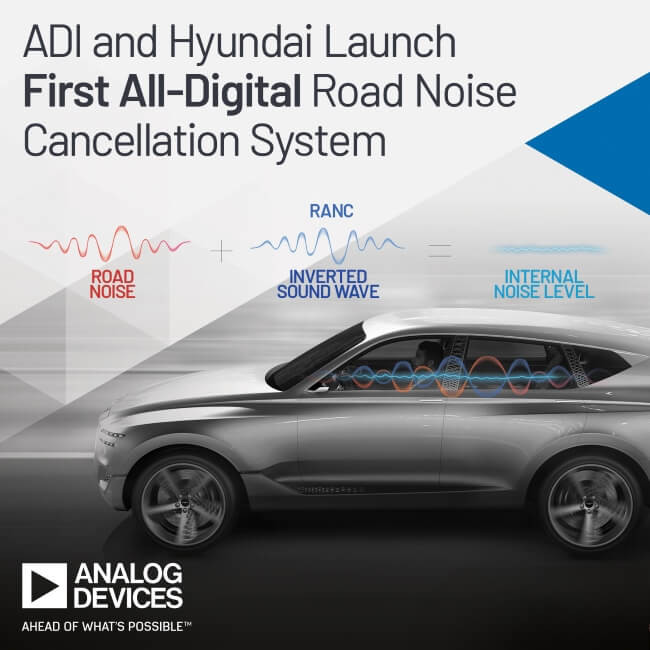ADI and Hyundai Launch All-Digital Road Noise Cancellation System Collaboration
| 05-02-2020 | By Rob Coppinger
Hyundai’s Road-noise Active Noise Control (RANC) system is to use Analog Devices Inc’s Automotive Audio Bus (A2B) technology for an industry first all-digital offering.
Hyundai’s RANC system dramatically reduces noise within the cabin of a vehicle. The system can analyse various types of noise in real-time and produce inverted soundwaves. The inverted soundwaves, when broadcast into the cabin interior, cancel out the original noise for the occupants. For example, there are different types of road noises that the new technology can process, such as resonant sounds created between tires and wheels or rumble sounds coming up from the road. The inverted versions of these sounds will cancel that tire, wheel and road rumble noise.
“As an early A2B adopter, we realised the potential of this technology for not only our Road-noise Active Noise Control systems but also for other vehicle applications fundamental to passenger and driver experience,” said Hyundai research fellow, Doctor Kang-Duck Ih. “The low latency guaranteed by A2B enabled us to implement this ground-breaking RANC technology and accelerate its deployment to mass production.” Hyundai also intends to more broadly adopt ADI’s A2B technology for its fundamental audio connectivity and infotainment applications across its automotive fleet.
Quality sound
With a configurable 44.1 kilohertz (kHz) or 48 kHz frame rate and up to a 50 Megabit per second bandwidth, A2B is ideal for transporting digital audio and delivers superior audio quality relative to analog connections. System nodes support up to 32 bus slots in each direction, and the slot widths are programmable up to 32-bit, thereby supporting I2S and numerous TDM configurations up to TDM32. PDM input is also natively supported, with the transceiver decimating the input to PCM format before placing it on the A2B bus.
ADI’s collaboration with Hyundai also emphasizes the growing importance of A2B for automotive manufacturers in emerging wiring intensive and latency sensitive applications for road noise cancellation, in-car communications, and personalised audio or sound zones. ADI’s A2B technology significantly reduces associated wiring harness cost and complexity found in traditional analog-based road noise cancellation system deployments. The A2B reduces cabling weight by up to 75% and improves automotive fuel efficiency and total system costs.

Credit: Analog Devices
ADI’s A2B is the industry’s lowest latency, high-speed digital interconnect technology distributing audio and control data together with clock and power over a single, unshielded twisted-pair wire. The deployment of automotive road noise cancellation systems has been constrained by the availability of a cost-effective, low latency networking technology that efficiently connects required input sensors to a central processing unit.
“We have collaborated closely with Hyundai to architect its all-digital RANC system that leverages our A2B technology to reduce equipment cost, weight, and design complexity, and in turn, improve overall fuel efficiency – helping solve several challenges of the electronic RANC system,” said ADI Automotive Electrification and Infotainment vice president, Patrick Morgan. “ADI’s work with Hyundai demonstrates A2B’s increasing viability and further distinguishes Hyundai’s vehicles in today’s marketplace.”
